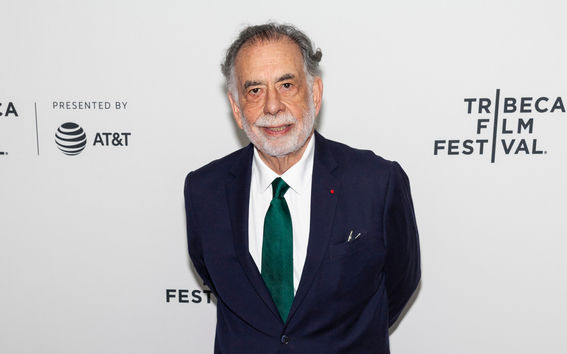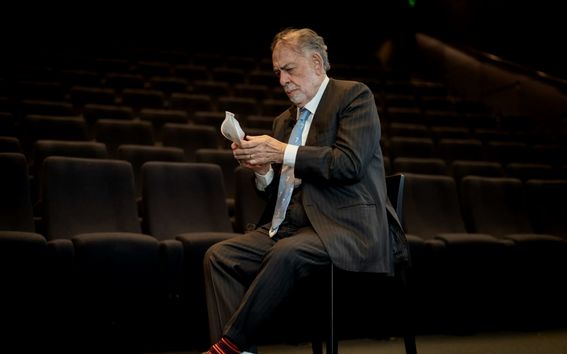Francis Ford Coppola: ‘I am a student of cinema’

Coppola, 81, discussed with the students and answered their questions, reminiscing vividly incidents and anecdotes from his life-long path as a filmmaker.
He said that one of his first impressions as a drama and theater student at around age of 20 was the tiny shock to realize that within the theatre everyone is called by their first name, even the absolute masters, the ones on the ‘highest level’. ‘I found it very difficult to do that, but that’s how it is.’
To begin with, Coppola modestly stated: ‘This can’t be a master class, because I'm not a master. There are some masters in cinema, but I don’t know how many of them are alive now.’
He reminded the audience of the fact that cinema is still quite young, 110–120 years. ‘I feel I’m still a student, because I’m still learning so much of it I didn’t know’, the director said. ‘We’re all students of cinema. I think I’m going to learn a lot from you while we’re talking for the next hours.’
Of all the aspects of cinema, that this bunch of film enthusiasts in the same room could talk for days and days, and which each one of them he highly values, Coppola said the two most important basic elements to him are writing and acting.
‘If those are beautiful, you have a beautiful film’, he said. ‘We have to accept that cinema is a child of theatre.’
Famous for numerous films throughout decades, mister Coppola still wants to learn more of cinema.
‘I always change the style of the movie, because I want to learn. I don’t do the same film twice. I never learned to do anything really well, since I always changed the style, to meet the theme of the movie. So, I haven’t had the time to develop to be good at something. I think the most important thing is to learn.’
Cinema is all about magic
First, when film industry started, Coppola underlines, the filmmakers were ‘magicians’. He reminds us, that television was developed at the same time.
‘It could have been possible that television would have come first. But good luck it didn’t. Because that’s how we first learned to tell stories with pictures, not with sound.’
He says cinema is all about magic. Whenever we see just a glimpse of a movie, even if while cruising through the television channels, we know immediately that it is a movie – since it is different, it has all the magic.
Francis Ford CoppolaI never learned to do anything really well, since I always changed the style, to meet the theme of the movie."
He points out, that when the film got sound, after some 30 years of silent cinema, everything was possible. He says cinema today owes much to its first decades: how things were possible to make with all the limitations directing what and how things can be made.
‘Cinema was photochemical for so many years, and therefore, the rules of cinema were made what they were – and they still are the same. Now it’s all digital, but even now that we have the new magic cinema that doesn't have the limitations, we still like the old way of cinema. We still make films to be like the old ones we love, when the pioneers of film, our ancestors couldn’t do all possible things.’
The students wanted to discuss the change in the film industry and what Coppola thinks could and should be brought from the old filmmakers, like from the 70s, to today’s filmmaking. He quickly replies it’s the financiers and the studios who have had the power, always.
‘What happened in the 70s was that we took the power for a while. We borrowed it for some years. Then they took it back.’
‘If you want to know who’s running the world, look and see who’s employing the artists. Now it seems to be the companies, basically the commercials. Today more artists are employed to make commercial messages than anything else’, he continues.
The most important talent: individuality
The director was asked if he thinks one can make great art without suffering.
‘I think you can. But you cannot make great art without a risk. When you’re going right to the edge of something important, and it may be you’re not succeeding in pulling it off. There’s always a risk. You're risking everything and you might suffer.’
Coppola openly reveals he suffered when making films. Being young with family, having no wealthy background, he says he was scared, always on the verge of a total failure. ‘I wasn't going out having fun but stayed up all night trying to find ways to support my family. I hadn’t a god-given talent, like Roman Polanski, Steven Spielberg or William Wilder...’

Yet, Coppola stresses, everyone has the gift of individuality. His tip to young filmmakers is to make personal films: ‘Make the kind of films that express who you are. Why waste that opportunity, why not make something that only you can have made.’
To film directing students, asking about how to approach having a camera when writing and acting, Coppola states the mistake that’s made with the directing students is with the camera.
‘I would make your first year of not going nowhere near a camera. I would have only you direct one at place. Just work on the text, the writing part, and the actor, without worrying about the camera.’
‘I’ve never seen a film school in the world where their film students have a relationship with the actors.’
One of the great learnings for Francis Ford Coppola was the time of being an assistant for Roger Corman. ‘I got to do a lot of stuff, and it all had to be really cheap’, he says. ‘I learned how to take the sound and much more, but, first of all, I learned how to make cinema really cheap, and that is good to know.’
When the students wanted to know what Coppola considers the most important thing in a script, he replied: ‘The theme, what it is all about. What’s the essence, the core of it – with one word.’
He describes his own films with the same philosophy, with just one word: for Godfather it is succession. For The Conversation privacy. For Apocalypse Now morality.
Costumes make the character
In Coppola’s opinion, costume design is ‘super important’. ‘When you see a character on a screen, what they are wearing is who they are, how the costume makes them. Costumes are near to the actor, all clothing and hair. They are important to the director because of this. And because costumes make the audience understand better what the characters are.’
It’s also about practicality. If the character always wears the same jacket, it gives more flexibility to reorganizing the film.
‘Who knows who is the highest paid person in the group, often?’ Francis Ford Coppola asks the students and replies: ‘It’s the make-up and hair. Because it is about the confidence of the star actor. Movie business is like a circus, the same mentality and how it works.’
Francis Ford CoppolaMake the kind of films that express who you are. Why waste that opportunity, why not make something that only you can have made."
The costume design students raised a question on what inspired Coppola to make the Bram Stoker’s Dracula a costume-driven film.
‘My idea was crazy: to make the costumes to be the set. I didn’t want to have sets for the film, only space. I decided to make the whole film on the stage. All of the Dracula was shot in a studio.’ One reason to that, according to the film director, was that the financiers were worried the film wouldn’t be finalized, or it would cost too much.
‘I had this concept to make the film in the style of the early motion pictures. It was made in the style the movies were made those times, when the Dracula story was written, in a studio. So, the costumes must be made very interesting: they were the sets’, reveals Coppola.
Production designer needs an ability to ‘translate’
The students were also inquiring what Coppola shares and talks with the production designer; how he gets them to create what he expects and needs.
The filmmaker tells a story from back in times, about him hiring a production designer for the film Godfather, who had experience in theatre. But then, however, he felt it was wrong, and he chose another person who had never done theatre, but who had all new, fresh ideas. That opened his eyes.
‘I realized his ideas were really good, and understood I need to get my own ideas off my head and see that the others have good ideas. See, my job is to be responsible of everything, but I don’t have to decide on every single detail.’
He says he’s happy to give the credits to the ones whose ideas the good choices have been.
What will be needed from the future producers, then? What should the students focus on to be good producers?
‘It’s much about money: what is needed and can be had to create the film the way the filmmaker wants to make it. You’ve got to translate the idea, the wish into several individual details. A good producer will and has to limit the high expectations’, says Coppola.
Sound design is poetic
Francis Ford Coppola likes to talk about sound design. He tells about the time when he started working with film in San Fransisco, having not much money, him and his assistant George Lucas and others.
‘We knew that, in the movie, picture and sound had equal importance for the audience, but the sound was cheaper to make. We decided to have our own studio for making the sound. So, movies that we made had great soundtracks’, Coppola rejoices.
He underlines the sound does not have to be that literal, but it could be more poetic approach to sound. ‘The beauty in that is to try catch the emotion. Things don’t have to be what they are, they can be what you want them to be.’
The cinematographer students asked how Coppola gets everyone in his crew to go to the same direction. He reveals his method is to always involve the people from the beginning. He wants to do some pre-visualization first, to see to what extent to sketch the scenes.
‘My rule is to have the person, the actor, for three weeks but I might get them only for one or two weeks, just to sit in a room together and we read the script together, and then we start learning from each other. We play theater games, improvisation, to get to know each other and to find the idea for the character. Then we make the scene.’
He says it’s important to find and create the joint ‘memories’ for the characters, those that bind them together.
‘Remember: the emotion is in the people, the audience, not in the film. It just blocks it.’
Read more news

Get to know us: Associate Professor Maria Sammalkorpi
Sammalkorpi received her doctorate from Helsinki University of Technology 2004. After her defence, she has worked as a researcher at the Universities of Princeton, Yale and Aalto.
Aalto computer scientists in ICML 2024
Computer scientists in ICML 2024
HRH Princess Maha Chakri Sirindhorn of Thailand visited Aalto University
During the visit, HRH and her delegation met with Aalto students and explored various activities.